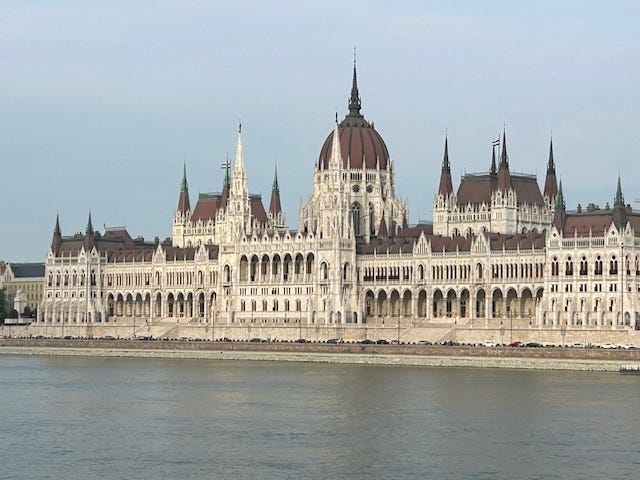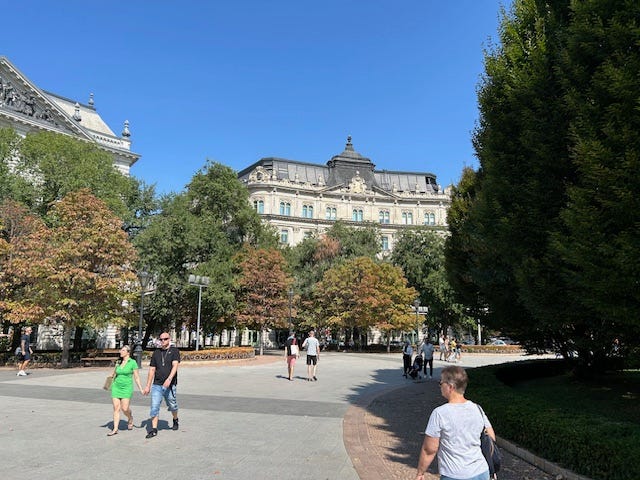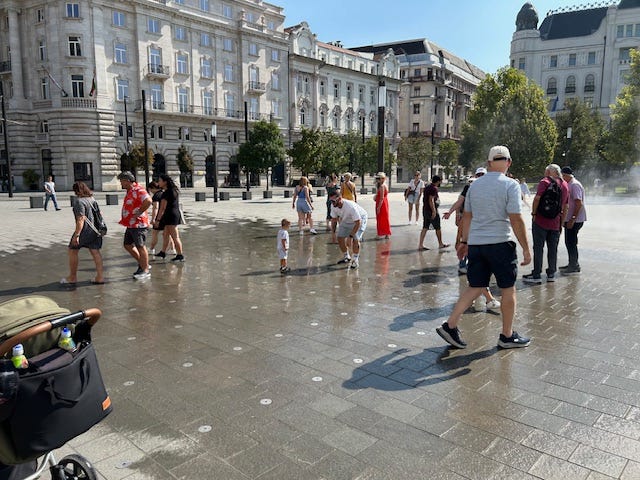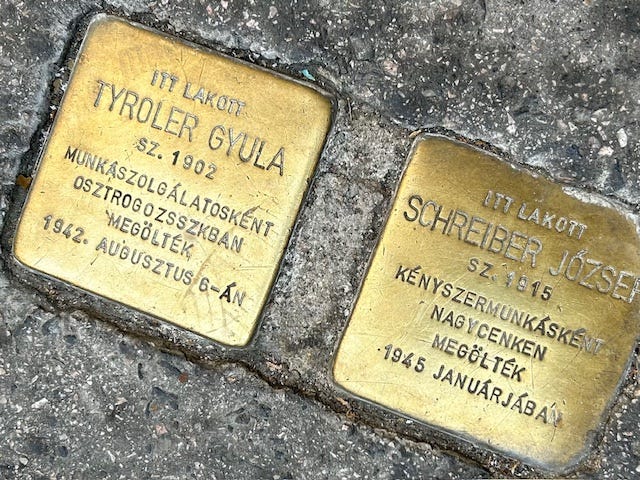Budapest as a Refuge from the Woke
This vibrant, energetic city on the Danube is a testimony to what cities can be if leaders listen to their own people, not to multinational corporations
You can see immediately why bestselling author and conservative blogger Rod Dreher likes his adopted city of Budapest: it’s right there on the beer bottles!
I arrived in Budapest in the late afternoon as I usually arrive in cities – that is, hot and tired and in a cranky mood from nonexistent airline food. The 100E bus from the airport, like most airline transports, takes you along the least scenic route to the city center.
Then again, it only costs $3 instead of $40 for a taxi. In Budapest’s case, however, public transport means driving past mile upon mile of dilapidated Commie tenements now falling into even more disrepair, covered with pseudo-Gantsa graffiti.
The neo-Gothic Hungarian Parliament Building on the Danube is the third largest legislative building in the world.
By the time the bus let me off near the apartment I rented, at Kálvin Square near the Hungarian National Museum, I was almost falling over from the heat. It’s early September and the temperatures are in the mid-90s Fahrenheit. I can’t help but think: Good God, what have I done? I could be visiting Zurich where it’s cool and there’s a lake!
I stumbled the few blocks to my apartment building, entered the main door digital keycode I had received, and dropped off my bags. I then went in search of a cold beer and something to eat.
And that’s when I saw it: right there on the beer bottle I ordered was Rod’s name in bright white letters: “Dreher.” It’s the Coors of Hungary, one of the most popular of Hungarian beers (brewed since 1854!).
I, too, might be warmly disposed to a country that named its national beer after me – even though I do have a nice island in Florida and a Kansas town named in my honor.
The Magical City on the Danube
Dreher, of course, is perhaps the most famous of Budapest boosters… but there are many others. I’ve been regaled by family and friends for years about what a magical place this venerable city on the Danube actually is.
Famous for its stunning architecture and beautiful women, Budapest has been a symbol of Central European elegance and sophistication for as long as I can remember. My daughter visited during a Model United Nations field trip her senior year in high school, and announced that I just “had” to visit Budapest (although, truth be told, she liked Vienna even better).
The real reason people talk about Budapest, however, is due to Hungary’s determination to preserve its capital city’s best qualities from all the cultural “enrichment” EU leaders seem determined to inflict on the rest of Europe – mass migration of young men from the Middle East and Africa, an epidemic of violent crime, drug addiction, entire villages of homeless living on the streets, and a general sense of cultural decline and desperation.
Budapest, it is said, has been spared much of this.
It is a city where young women in tight mini-dresses walk safely late at night, strolling from ruin bar to ruin bar in the Jewish Quarter, and not worry about being raped by gangs of Muslim men.
Very few young Hungarians appear to sport tattoos, and those that do limit themselves to a few discreet “tramp stamps.”
The stench of cannabis is virtually nonexistent, and while I do occasionally see people sleeping on park benches, the streets and parks are free of tents and other signs of permanent homeless encampments.
Because I’m staying for only ten days, I’m walking all over the city and am using the tram lines regularly. As is my custom, I’m also staying in an inexpensive apartment in a “working class” district near the Danube, and there is nowhere I feel uneasy walking late at night.
This is in dramatic contrast to, say, America’s capital city of Washington, DC, with one of the highest murder rates in the world, where on a recent visit I had to avoid three-quarters of the city after dark if I didn’t want to get mugged.
A Modern City Lacking in Diversity
Much of this is due to Budapest’s lack of diversity and resistance to multiculturalism. This gives Budapest a definite “old world” vibe – that, and the stunning neo-Gothic architecture.
When I was younger, say 40 years ago, when you visited a European city you expected to meet, well, Europeans, and you did. When I visited Paris when I was 19, virtually everyone I met spoke French and was French. That was the reason you visited France!
The same was true of my youthful visits to Munich, Copenhagen, Rome, Malaga, and so on. When I visited Munich, I interacted exclusively with Germans, ate German food, tried to speak German, learned about German culture, and so on.
Today, throughout western Europe, that is often not the case.
Many European cities, like many cities in North America, enjoy the cultural enrichment of diversity.
They resemble the polyglot Los Angeles of the Ridley Scott dystopian film Blade Runner, a multicultural food court in which thousands of Koreans, Nigerians, Chinese, Ethiopians, Somalis, Russians, Italians, Mexicans, Bangladeshis, Indians, and Filipinos all crowd together speaking hundreds of different languages and with whom few have anything in common with their neighbors.
This United Nations phantasmagoria can be fun for a day or two, but on a daily basis – as a place to live – it’s exhausting. Anyone who has moved to London recently knows this. When half the women on your street wear bourkas, it’s difficult for a westerner to feel at home.
This is not Budapest.
Budapest, for all its faults, is Hungarian through and through.
It’s a large, bustling, crowded, energetic, very modern European city full of Hungarians. (Unlike London, where the population is now only about 36% native British.)
The Mystery of the Hungarian People
I know all this because I can’t understand a single word anyone is saying. Not one. This means they’re speaking Hungarian, perhaps the most incomprehensible language on earth to non-native speakers. More about that in a moment.
The only foreigners you run into are tourists (Israelis in the Jewish quarter, Chinese tourists taking pictures) and Thai women asking if you want a massage. The ratio of tourists to residents seems incredibly low. I am regularly approached by people on the street, asking for directions in Hungarian, so that means people assume that those they meet are likely residents, not tourists.
As for the Hungarians themselves, they look for all the world like a group of fit midwestern Americans or Bavarian Germans at a picnic in the park: in fact, it’s eerie how much they resemble ordinary Americans or Germans. They’re a good-looking bunch, the young men tan and flexing their biceps, the women flashing cleavage. They’d be at home at any mall in Los Angeles or Frankfurt.
Except for one thing: it appears the Hungarians are actually from another planet.
They speak a language that is utterly unlike any language on earth (except for Finnish) and totally distinct from the languages of all their neighbors.
The best historians can determine, the world’s 15 million Hungarians are the descendants of nomadic tribes originally from one side or the other of the Ural Mountains in Siberia, in the far north of what is now Russia. Sometime in the first millennium, these ancient tribesmen, who called themselves the Magyars, left their homelands and gradually headed south towards central Europe and the Carpathian basin.
They spoke an early version of Hungarian known as Proto-Uralic – a non-Indo-European language. One group of these people broke off and headed north, eventually settling in what we now call Finland. But their languages developed independently so that Finnish and Hungarian today, although sharing many similarities, are no longer mutually intelligible. (To my untutored ear, however, Hungarian has many of the same tonal qualities I hear in the Finnish detective TV series I compulsively watch at home.)
In other words, this unique tribe of nomads spoke a language unlike any of the other peoples then in the area – not the Latin of the Romans, or the Celtic languages of the Celts, or the early German of the Germans, or the Basque language of the Basques. It’s utterly unique.
By the early Middle Ages, the Magyar tribes were raiding settlements across central Europe. However, around 800 A.D., these raiding peoples cast their eyes on the lush meadows of the Carpathian Basin, a vast lowland tucked between the Carpathian Mountains to the north and the Alps to the west. A pagan prince settled his people in the area, driving out other groups, and, as legend has it, the pope agreed that they could settle in and take possession of the Carpathian Basin if they agreed to convert to Christianity – and that is precisely what they did.
An Ancient Catholic Country
The warlord known as King St. Stephen I, born to baptized Christian parents, committed his people to the Christian religion and was crowned the first king of Hungary on Christmas Day in the year 1000 A.D., with a crown perhaps sent to him by Pope Sylvester II. They still have the crown, the oldest royal crown in continuous use.
The giant bronze statue of King St. Stephen I looms atop Fisherman’s Bastion fortress in Budapest
The basilica in the center of Budapest, St. Stephen’s Basilica, was built in the king’s honor and contains a macabre relic of the man himself – his mummified but still recognizable right hand – triumphantly and creepily on display in the glass case at a side altar.
Thus, Hungary was a kingdom that lasted for roughly 900 years, despite invasions by the Ottoman Turks and rule by the Austria-Hungarian Empire (with the emperor taking on the title of King of Hungary).
All this came to a screeching halt with the “brother wars” of World War I and World War II.
After World War I, the victorious allies divvied up roughly 40 percent of Hungarian territory to various real and invented states (Hungary’s neighbors). That’s why Hungary today is “surrounded by Hungarians” in Serbia, the Czech Republic, Slovakia and so on.
This is also why Hungary reluctantly sided with the Axis Powers in World War II.
The Catastrophe of Europe’s Civil Wars
Hitler promised Hungary’s leaders that they could regain the lands taken from them after World War I and that he would help Hungary resist Soviet communism. At the time, Hungary had one of the largest Jewish populations of Europe, roughly ten percent of the population.
To appease Hitler, Hungary’s leaders adopted harsh anti-Jewish employment measures but refused to deport or harm Hungarian Jews. As the Holocaust memorial organization Yad Vashem puts it, “most of the Jews of Hungary lived in relative safety for much of the war.”
However, by the end of the war, the Hungarian government was secretly making peace overtures to the Allies and the Nazis responded by invading Hungary in March 1944.
This is why the catastrophe that befell Hungary’s large Jewish population happened all at once in one brief period beginning in May 1944, when 434,000 Hungarian Jews were deported to Nazi death camps, primarily Auschwitz, and gassed.
Bronze “tripping stones” throughout Budapest mark the former residences of Jews and others killed or deported by the Nazis at the end of World War II.
In October, 1944, just months before the end of the war, Hitler removed Hungarian Regent Miklós Horthy from power, installed a pro-Nazi puppet as prime minister, and proceeded to wipe out the remaining Jewish population of Budapest.
Nearly 80,000 Jews were lined up on the banks of the Danube River, told to remove their shoes, and shot at point-blank range, their bodies simply thrown into the river. That is why there are now 60 pairs of iron shoes lining the banks of the Danube near the Hungarian parliament, a memorial to those who lost their lives.
It was one of the great tragedies of World War II, the last-minute mass murder of Hungarian Jews, organized by the notorious Adolf Eichmann, right at the end of World War II.
It is also why the Soviet Union had the excuse to “liberate” Hungary from the Germans and then impose its flat-earth Communist ideology for the next 45 years – despite the Hungarians rebelling outright in a heroic but doomed uprising in 1956.
What all this means is that the Hungarians are a very ancient people who have lived in the same basic area in Central Europe -- preserving their linguistic and cultural identity despite multiple conquests – for at least a thousand years and probably longer.
Preserving Hungary for Hungarians
They may look and dress like they should be in a Calvin Klein ad, their Apple earbuds firmly in place, but Hungarians have a fierce sense of national identity borne, at least in part, by their linguistic isolation. At least 93% of the people who live in Hungary today are ethnically Hungarian.
Your hard-working correspondent posing with statue of Ronald Reagan in Budapest’s Liberty Square
All this goes to explain why Hungarians don’t really want the “enrichment” and diversity of mass migration that EU leaders inexplicably demand. They’ve seen the riots, stabbings and rapes being perpetrated in other European cities – by groups of migrants angry that they’re not being given more benefits – and frankly want nothing to do with it.
As with most polls of European citizens, polls of Hungarians show that the overwhelming majority support the strong immigration laws promoted by the Hungarian Fidesz Party and Prime Minister Victor Orbán, a man regularly denounced by EU bureaucrats as a “strong man” for his refusal to accept the quotas of impoverished migrants the EU demands of Hungary.
As in America, polls in Europe are highly politicized and used primarily for propaganda purposes, their results dependent upon the data sample and the way questions are phrased. Nevertheless, poll after poll has shown that roughly 70 percent of Europeans believe that their countries take in too many migrants, according to a recent survey carried out by BVA Xsight.
In other words, Hungary is doing what most Europeans actually want, preserving their country as a homeland for their own people.
Because of the rapid rise of anti-immigration, populist parties in France, Germany, Denmark, Sweden, Italy and the Netherlands, EU bureaucrats recently created a reform of immigration policy dubbed the New Pact on Migration and Asylum, approved by 27 nations of the EU despite opposition from Hungary and Poland.
As with similar proposed legislation in the U.S., the new rules allow for greater vetting and detention of illegal migrants and “asylum seekers” but still allow for massive numbers to be allowed in. The EU pushed this reform to quash the rise of populist parties but, apparently, to no avail: recently, Germany’s anti-immigration Alternative for Deutschland (AfD) party received the greatest percent of the vote in its history.
Visit Budapest to See What a City Can Be
In the end, Budapest is a bracing example of what European nations are losing: it’s the proud capital of a proud people, one determined to maintain its nation, culture and history.
One final initial observation: everywhere you go in Budapest, you see construction going on with massive scaffolding and cranes in place.
They are rebuilding everything, healing decades of government neglect and the deliberate destruction of their historical monuments – a reality that ordinary Americans have seen in their own history recently. For example, the Communists destroyed many monuments of Hungarian history and royal buildings in the Buda Castle, tried to destroy St. Stephen Basilica (the center of Catholicism) and succeeded in placing the Marxist Red Star atop the Hungarian Parliament.
Yet today, old royal buildings are being completely rebuilt according to extant architectural plans. Entire neighborhoods are being refurbished. There is an energy and optimism here – as well as vast amounts of money being spent – that are lacking in many decaying American inner cities.
Budapest shows you that large cities don’t have to be ugly and dangerous. In fact, they can be magnetic places people want to live in, bustling urban centers that are safe at night and full of energy and excitement.
And in the end, that’s the reason to visit Budapest: to discover what cities can be.
They don’t have to be urban ghettoes from which families flee to the suburbs for safety. They can be just the opposite. They can attract young families eager for the culture and energy and excitement they provide. Visit Budapest to experience what cities can be, if only our leaders would listen.
Robert J. Hutchinson is the author of numerous books of popular history, including Searching for Jesus: New Discoveries in the Quest for Jesus of Nazareth (Thomas Nelson), The Dawn of Christianity (Thomas Nelson), The Politically Incorrect Guide to the Bible (Regnery) and When in Rome: A Journal of Life in Vatican City (Doubleday). Email him at: roberthutchinson@substack.com








